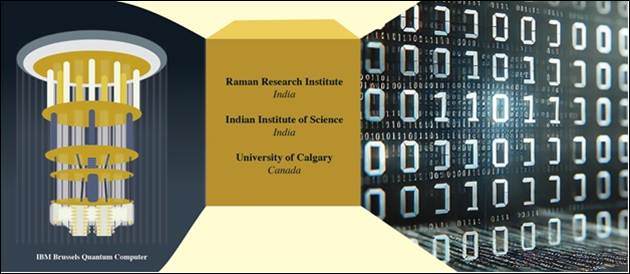Ministry of Science & Technology
Scientists certify true randomness marching towards a digitally safe world, one qubit at a time
Posted On:
01 OCT 2025 2:09PM by PIB Delhi
Researchers have shown that Certified Quantum Randomness can be achieved using simple time-based tests on a single qubit – a novel step beyond earlier complex multi-particle setups. This opens a path toward un-hackable digital security.
Randomness is essential for securing everything from bank accounts to encrypting private discussions, yet computers alone cannot generate actual randomness. They use a predictable set of rules, so in theory even these "random" numbers can be guessed. The quantum world, however, is fundamentally random at its heart, and if we can design experiments accordingly, we can harness the randomness to produce numbers that really are a reliable source.
In just three years, this line of research has remarkably progressed at the Raman Research Institute (RRI), an autonomous institute supported by the Department of Science and Technology (DST), Government of India with a series of publications turning discovery into device.
“Our trilogy advances one idea across three frontiers—rigorous foundational validation, practical certification of randomness, and deployment—culminating in certified randomness running on quantum computers in the cloud,” said Professor Urbasi Sinha, head, Quantum Information and Computing (QuIC) lab at the RRI.
As a landmark experiment, the researchers at RRI in 2022 published an experimental result to ascertain whether the world is classically predictable, or governed by the tenets of quantum mechanics. They decisively proved quantum mechanics right by using single particles of light called photons and testing their correlations in time. This was achieved by a strong experimental violation of what are called the Leggett Garg inequalities. In doing so, every possible loophole that could cast doubt was systematically closed together for the first time, thus establishing a loop-hole free photonic architecture.
The researchers then shifted from exploring the foundational principles behind the work to finding real-world applications. They used their loop-hole free photonic architecture to develop a quantum random number generator in a work published in 2024. This new device was capable of randomness generation certified by quantum mechanics. It produced random bits nearly a million units strong, the digital equivalent of a million-coin flips, and the randomness certified by quantum temporal correlations. This demonstrated that the fundamental physics behind this work was now ready for technological advancements in communication and encryption systems.
The most recent advance in this body of work now comes in 2025, when the team with collaborators from the Indian Institute of Science (and the University of Calgary), showed that certified Quantum Randomness could be realized on a general-purpose quantum computer available through the cloud and does not need elaborate optical tables or specialized labs. This shift was a major leap, because earlier demonstrations had depended on intricate, proof–of-concept optical arrangements and precise eliminations of hidden influences. Although rigorous, such an approach was practical only within highly specialized physics laboratories.
Certified randomness has been achieved earlier using entangled particles which are separated in space. However, a loop-hole free implementation is currently not feasible on available quantum computers. The innovation was to shift from separation in space to time. Rather than carefully separating particles over long distances, the scientists took one qubit – the simplest unit of a quantum computer, and devised a series of basic stepwise temporal measurements on it. By observing the qubit at different times, it was possible to quantum-certify the outcomes and measure the degree of genuine unpredictability.

Fig: The work done collaboratively by the three institutes enabled randomness to be certified by the laws of physics using an accessible quantum computer
This was not just a conceptual success, but a technological one. For the first time, randomness certified by the laws of physics – via temporal (Leggett-Garg) correlations – was generated on a commercially available, cloud-accessible quantum computer: IBM’s superconducting-qubit platform.
“The simplicity of this approach is precisely what makes it powerful. It showed that even today’s noisy and small-scale quantum processors can deliver a resource as fundamental as Certified Randomness” said Pingal Pratyush Nath, PhD student at the Indian Institute of Science.
The novelty lies in bringing an idea once confined to custom-built optics labs into a platform that anyone with internet access can, in principle, use. In addition, it helps broaden the scope of what quantum computers are capable of, extending from solving specialized problems, to now offering a genuine resource for secure communications. Certified randomness is integral for cryptography, especially for the plausibly secure systems where digital keys must remain unconditionally unguessable, and this research makes it plausible for such protocols to be executed on a quantum device easily. Simultaneously, the technique serves as a means to quantitatively assess the precision of individual qubits, providing a convenient yet effective validation of quantum hardware.
By proving that certified randomness can thrive both in delicate optical setups and in the chips of commercial quantum processors, the researchers have provided not only a powerful tool for secure technology, but also a striking benchmark of quantum reality itself.
***
NKR/PSM
(Release ID: 2173517)
Visitor Counter : 1472